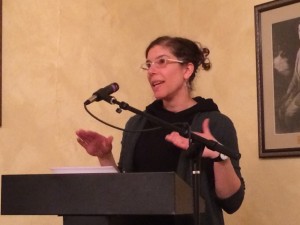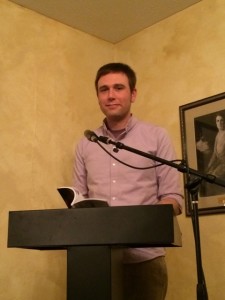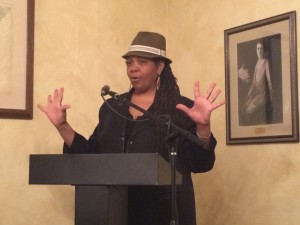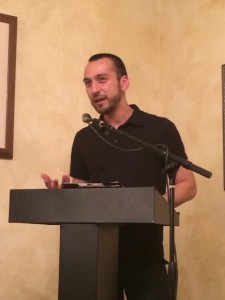Adrienne Dodt, Series Contributor
Adrienne’s series “Digital Landscapes” is about navigating hypertext.
I first encountered Jena Osman’s The Periodic Table as Assembled by Dr. Zhivago, Oculist in a New Media class in college around 2003. I returned to TPTAABDZO (hosted on gtrlabs.org) again in 2008-2009 because I wanted to include it in my master’s thesis (though I eventually didn’t), and I took rather extensive notes on it.
Some time later, though I couldn’t say exactly how much later, I was interested in reading TPTAABDZO again. However, when I attempted to access it, I was instead confronted with a dancing banana. It smiled as it moonwalked across the page and shook its little banana rump, as though mocking me.
I tried gtrlabs.org’s home page, and, again, there was that damned banana.
The Periodic Table as Assembled by Dr. Zhivago, Oculist was a digital text in the shape of the periodic table of elements, and each element was a poem. One could read individual poems, combine elements/poems, and subject them to any (or all) of five different processes (“Dissolve,” “Stir,” “Heat,” “Dilute,” and “Centrifuge”) to see text “reactions.” Each of these processes had a “Solution” (that is, what the process did to the text), and, in her descriptions of the processes, some of them had an “Ideal Solution” as well as a “Current Solution.” Even in this very finished stage of the text, there was still this built-in assumption that, given improving technology, she would eventually be able to enact these “Ideal Solutions.”
In 2011, an updated (and the current) version of The Periodic Table as Assembled by Dr. Zhivago, Oculist appeared at jenaosman.com. The text, as far as I can tell, hasn’t changed. The processes, however, are different, including a new process, “Evaporate.” Some of these processes now enact older “Ideal Solutions,” and others are simply different with no relation to a stated “Ideal Solution.” In this way, Osman’s text evolved and attained more desirable traits in the face of threat to its environment.
In researching (a.k.a. “Googling”) The Periodic Table as Assembled by Dr. Zhivago, Oculist, I found an even earlier version from 1997 on SUNY Buffalo’s Electronic Poetry Center. It is a sort of proto- TPTAABDZO: there is an uninteractive image of the periodic table of elements, then text and element boxes. There are a few links which lead to more poems, but the majority of the text is on the main page. It is a lot less hypertextual than today’s version, and there are no processes. It is almost unrecognizable as TPTAABDZO‘s ancestor.
Last summer, I went to see Stephanie Strickland read at Woodland Pattern Bookstore in Milwaukee. She had a new book out: V: WaveTercets/Losing L’una. Or rather, the new book was an update of her 2002 book, V: WaveSon.nets/Losing L’una. Both versions of the book have two parts that one can access by flipping the book over to read one part then the other. The third part of the book, V, is a digital component to the book, again in both cases. At the reading, I casually picked up the new version and asked Strickland what the difference between WaveTercets and WaveSon.nets was. I was expecting there to be a textual difference. I was surprised when she answered, “Shockwave.” V had been endangered because of the gradual obsoletion of Shockwave. In the updated version of V, it appears as an iPad app. The printed books are only different in one aspect: the sonnets are now cut into tercets instead. The materiality of the written text was altered in order to re-present the overall work in a contemporary digital environment.
Both The Periodic Table as Assembled by Dr. Zhivago, Oculist and V have survived because their authors were able to re-home them. Many other works have not been so fortunate.
Digital technology is, as they say, “rapidly evolving.” A machine can become obsolete in only a few years. Little by little, programs stop updating for an older machine until one day, the machine simply cannot run these programs. The machine becomes a wasteland, still mechanically sound but unable to produce. Websites and software, too, must be consistently maintained and updated in order to avoid obsolescence.
Hardware and software are the environment, and the works themselves are the flora and fauna. Digital literature must adapt (and must be adaptable) in order to survive in a constantly renewable, constantly evolving landscape on the internet. Digital poems must constantly adapt or die, but then there’s the added problem that the new adaptation may itself prove to be incompatible in the future.
Lori Emerson, in her blog post “The Archeological Media Lab as Locavore Thinking Device,” argues that the best way to preserve digital literature is to preserve obsolete machines. Lori Emerson founded the Media Archaeological Lab at the University of Colorado Boulder in 2009, which preserves obsolete technology such as game consoles, electric word processors, and circuit boards. She writes that it’s difficult to preserve “the material specificity” of e-lit that was created in now-obsolete machines and programs.
She believes the solution is to use original hardware/software to run older e-lit as it was originally intended. She argues that while archival projects such as the Electronic Literature Organization (ELO) and Electronic Literature as a Model of Creativity and Innovation in Practice (ELMCIP) preserve older digital texts by translating them into more modern programs as simulations, making them accessible to current computers, the texts are expressed differently because they’re in different forms.
Emerson writes, “In terms of the literature created on these platforms from the past, I would say that a work such as First Screening by bpNichol—created in 1983-1984 using an Apple IIe and the Apple BASIC programming language—is exemplary in that it, like most other early works of e-lit, cannot be understood if we view it only via a media translation.” She goes on to describe First Screening, that one had to physically insert a floppy disk and type command lines, something completely foreign to modern computers. Because this text roamed a different land, much like the dinosaurs, it is ill-suited to contemporary environments.
While the Media Archaeological Lab functions as a sort of museum, sites like the ELO and ELMCIP function as Jurassic Park, minus the rampant predation. Fitter versions of extinct texts are brought to life in contemporary digital environments. Although they are not the original dinosaurs, and their coloring may be slightly off, it is a way to make these megafauna of e-lit history accessible to a wider audience. That is immensely important because what survives depends on human interest. If we restrict these texts to their original, obsolete machines, they will become extinct because eventually, there will be no one familiar enough with the texts to want to preserve them.
In “Acid-Free Bits: Recommendations for Long-Lasting Electronic Literature,” Nick Montfort and Noah Wardrip-Fruin advocate for the preservation of digital texts. They first give four different methods of preservation, including Emerson’s, and the pros and cons for each. (Maintaining obsolete machines, they point out, is “a costly and difficult option.”) While Montfort and Wardrip-Fruin are more open to different methods and different preferences (including the idea that digital lit should go extinct, that it’s an ephemeral medium), they do recommend best practices for keeping various species of digital text thriving. This involves keeping the source code for future re-creation, saving it on many different storage options in case one becomes obsolete, making many copies and making it copyable for others, keeping it open and non-proprietary, and creating programs that are as universal as possible across different operating systems. Essentially, develop programs with less specific environmental needs, store the DNA, propagate widely, and create zoos.
Montfort and Wardrip-Fruin end their essay by promoting The Electronic Literature Organization’s project X-Lit (part of the larger ELO PAD initiative), which serves to give authors the tools for making preservable digital text. In the sequel to this article, “Born-Again Bits,” by Montfort, Wardrip-Fruin, and several others, the authors outline the ELO’s PAD project (Preservation, Archiving, and Dissemination), and they include a more detailed description of the X-Lit project. Another goal of the PAD initiative is to migrate older hypertextual works to suitable contemporary environments through the use of emulators and interpreters. They argue that “migrating” the works into different programs is the way to preserve them, not keep them on the “life support” of old, eroding programs. A text in a dying environment, if it does not migrate, will die unless artificially preserved, and the authors believe it is much better to give a text a new environment rather than expend futile effort in maintaining it within its original environment.
They also contend that the work is not defined by its platform/environment, but that instead, “Complex digital works are a kind of swarm behavior. Individual files, formats, scripts, software environments, and so on, may perish, but suitable replacements may be found that allow the living relationship that is the swarm to continue.” Thus, the digital text is not an individual organism, or a relation between organism and context, but on the text as an entire species. In this way, the overall function of the work matters more than its constituent parts.
I don’t believe that this is truly an either/or proposition. We can have both the originals and the new media translations, and in having both, we can even better preserve both the interest in the texts and the ways in which they were originally intended.
The internet is a curious place where anything can be at once ineradicably permanent and instantly ephemeral. Websites are washed away like sand on a beach. Old platforms become obsolete, rendering digital literature unreadable or inaccessible. On the other hand, the internet is obstinately stained with scandal. Retracted articles that are reposted, screenshots that capture misdeeds, and stolen nude photographs can be pulled up as so many weeds that only grow anew somewhere else. The landscape, then, is cultivated by human interest.
In our digital environment, we are not only losing our art. We are losing our history. Future archaeologists will have little to go on if we do not preserve our digital culture even as it progresses. We obsessively catalog and classify our lives on social media and blogs. We can also do this with our digital texts. If we don’t, the future will only know us by our dancing bananas.
Corrections:
- In paragraphs 7-8, I incorrectly titled the online portions of V:WaveSon.nets/Losing L’una and V:WaveTercets/Losing L’una. V is actually the overall title of all the texts while Vniverse is the title of the two online portions of V.
- According to a soon-to-be published chapter of a book by Stephanie Strickland, “The Death and Re-Distribution of V” (which she helpfully emailed me), Shockwave wasn’t solely responsible for endangering V. It was also V:WaveSon.nets/Losing L’una going out of print and the Shockwave Vniverse and Errand Upon Which We Came (an earlier digital version of part of Losing L’una) not longer being accessible through The Iowa Review Web and the Cauldron and Net website, respectively. However, both Errand Upon Which We Came and the Shockwave Vniverse are still accessible through Stephanie Strickland’s website: www.stephaniestrickland.com. That is, the previous iterations have been preserved, so the evolutionary steps of this text co-exist today.
≅
 Adrienne Dodt is a poet and essayist. Adrienne’s work can be found in The Body Electric anthology and Fact-Simile, Apothecary, Con/Crescent, and Monkey Puzzle magazines. Ze is a member of The Next Objectivists poetry collective in Chicago. Ze was the Poetry Editor for Bombay Ginmagazine in 2008-2009, and ze edited the Next Objectivists’ chapbook Collective Unconsciousnesses in 2011. Adrienne currently teaches English at City Colleges of Chicago.
Adrienne Dodt is a poet and essayist. Adrienne’s work can be found in The Body Electric anthology and Fact-Simile, Apothecary, Con/Crescent, and Monkey Puzzle magazines. Ze is a member of The Next Objectivists poetry collective in Chicago. Ze was the Poetry Editor for Bombay Ginmagazine in 2008-2009, and ze edited the Next Objectivists’ chapbook Collective Unconsciousnesses in 2011. Adrienne currently teaches English at City Colleges of Chicago.
 Adrienne Dodt is a poet and essayist. Adrienne’s work can be found in The Body Electric anthology and Fact-Simile, Apothecary, Con/Crescent, and Monkey Puzzle magazines. Ze is a member of The Next Objectivists poetry collective in Chicago. Ze was the Poetry Editor for Bombay Gin magazine in 2008-2009, and ze edited the Next Objectivists’ chapbook Collective Unconsciousnesses in 2011. Adrienne currently teaches English at City Colleges of Chicago.
Adrienne Dodt is a poet and essayist. Adrienne’s work can be found in The Body Electric anthology and Fact-Simile, Apothecary, Con/Crescent, and Monkey Puzzle magazines. Ze is a member of The Next Objectivists poetry collective in Chicago. Ze was the Poetry Editor for Bombay Gin magazine in 2008-2009, and ze edited the Next Objectivists’ chapbook Collective Unconsciousnesses in 2011. Adrienne currently teaches English at City Colleges of Chicago.






